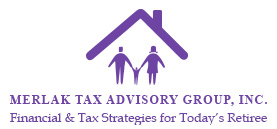Pay Fewer Taxes in Retirement with These Lake in the Hills Retirement Tax Strategies
We all want to enjoy our retirement, but how do you get the most joy out of it? Many retirees think it’s as simple as saving up enough money to live comfortably. And while saving enough is part of it, people often forget about one crucial detail: taxes.
Yes, unfortunately, taxes follow us into our golden years. And if you’re not careful, they can significantly cut into all that money you thought you saved.
Fortunately, you have some control right now over how much you will spend on taxes in retirement. By strategizing well, you can make the most of your tax situation both now and in the future.
At Merlak Tax Advisory Group, we help people develop Lake in the Hills retirement tax strategies every day. This blog will give you some guidelines for paying as little in taxes as possible in retirement to avoid outliving your money.
Understand What You Can Control and What You Can’t
No one knows what tomorrow will bring. That may seem like an obvious statement, but too often, people fail to grasp its significance when saving for retirement.
Unfortunately, people often save with only today’s tax rates in mind. They know they should start saving and want to avoid paying too much in taxes now, so they put all or most of their savings in tax-deferred accounts like 401(k)s or traditional IRAs.
The problem is, while the money goes into these accounts pre-taxed, you can’t avoid paying taxes forever. Eventually, once they start taking money out in retirement, the government will tax it like regular income. And the government requires people to begin regularly taking money out of these accounts at age 72.
But what’s the harm in deferring taxes until later in life? If you’re young and don’t have much money now, presumably, you’ll have more to handle taxes better then. And maybe tax rates will be better then than they are now.
Maybe that will be the case, but you don’t know that.
What you do know is your financial situation and the tax rates right now. And if you can handle paying taxes now, then you may want to do so to avoid potential higher tax rates in the future. Your future self will probably thank you!
In summary, the proper retirement tax planning mindset begins with weighing risks and rewards in both the present and future. Of course, this doesn’t mean you have to put yourself in a financial bind now to prosper then or vice versa. The key is to diversify so that you can be fiscally responsible both now and then.
Diversify Your Investments to Make the Most of Now and Then
It’s never a good idea to put all your eggs in one basket. For example, if you rely on only one type of savings account for retirement, then you will likely spend too much on taxes either now or in the future.
The best way to avoid this is to explore the wide variety of savings options available to you. A financial and tax advisor can help you choose a combination of accounts to create the most advantageous situation for yourself.
Here are just a few types to consider when developing your retirement savings plan:
401(k)
This employer-provided savings account allows you to contribute an untaxed portion of your income. The current limit for how much you can contribute in 2021 is $19,500 if you’re under 50 and $26,000 if you’re older. Your employer can then match part of your contribution.
A 401(k) is an excellent option to take advantage of if your company offers it. However, keep in mind that the money will be taxed once you start taking required distributions at the age of 72.
Traditional IRA
IRA stands for Individual Retirement Account. A Traditional IRA allows you to regularly contribute a portion of your income without paying taxes on it first. You can then manage that money as it’s invested and watch your savings grow.
Of course, just like a 401(k), the caveat is you will have to pay taxes on that money once you start drawing it in retirement. The IRS also limits the amount you can contribute per year to $6,000 if you’re under 50 and $7,000 if you’re over 50 as of 2021.
Roth IRA
Unlike a Traditional IRA, you can only contribute after-tax money to a Roth IRA. However, once you put it in, your investment will grow just like it would in a Traditional IRA, and when you start taking it out in retirement, you won’t have to deal with income taxes! Roth IRAs also don’t require you to start taking money out at a certain age, unlike 401(k)s or Traditional IRAs.
If you decide to go with a Roth or Traditional IRA, be aware that both types come with other rules, such as income limitations. Therefore, you should always consult a tax or financial advisor before funding one of these accounts.
Health Savings Account (HSA)
An HSA is a wise investment option to ensure you can pay for your healthcare needs in retirement. You can contribute pre-taxed money to the account and withdraw it at any time tax-free. However, you can only use the money to pay for medical expenses, such as deductibles or copays. You must also have a High Deductible Health Plan to open an account.
Brokerage Account
Unlike the other accounts listed above, a brokerage account isn’t considered a retirement account. Because of this, it can provide more flexibility, making it a great addition to your investment portfolio. Whereas retirement accounts place restrictions on how much you can contribute and when you can withdraw funds, no such limits exist on brokerage accounts. However, the money you invest is subject to income tax and may incur additional capital gains taxes as your investment matures.

Adjust as You Go as Circumstances Change
Whatever savings options you decide to go with, the critical thing to remember is you’re not locked into anything. There are many ways to adapt as circumstances change.
For example, let’s say you opened a Traditional IRA a few years ago but now think a Roth IRA may have been a better choice. The good news is you can do what’s called a Roth conversion. This strategy allows you to contribute pre-taxed money to your IRA, paying the tax rate of the year you contributed. Not only can this reduce the taxes you pay in retirement, but you can also pay low tax rates in the present.
Another way to adapt is to consider how much money you’ll lose to taxes on any investments you make. A financial advisor can help you select the right combination of taxable accounts and tax-advantaged accounts to ensure you won’t pay too much in taxes as you invest.
Plan for What You Will Withdraw and When
While it’s good to diversify your retirement savings, it can also create a problem when the time comes to start withdrawing money. Many retirees aren’t sure if they should draw from one account first or start taking from multiple accounts at once.
Unfortunately, there is no one-size-fits-all answer to this question. It may make the most sense for some retirees to start withdrawing from their tax-deferred accounts first to let other accounts like their Roth IRA keep growing. For others, taking a little bit from each account and then changing that proportion over time may make more sense.
The key is to work with a financial planner ahead of time to develop a strategy. That way, you’ll know what to withdraw and when once you retire.

Meet Regularly with Your Tax Advisor
With so many options to consider and so much uncertainty about the future, it’s not hard to see how retirement tax planning can get overwhelming. It’s especially stressful trying to figure it all out on your own!
For this reason, it’s never a bad idea to consult a tax advisor. An experienced professional can do many things to take the burden off your shoulders, including:
- Educate you on the savings options available
- Help determine which strategies make the most sense for your situation
- Develop a comprehensive plan for your financial future
- Help you adjust your plan as circumstances change
Plus, financial advisors can also help you with budgeting, saving for a significant purchase, loan payoff strategies and more!
Need Help in Lake in the Hills with Retirement Tax Strategies?
Saving money on taxes in retirement takes diversifying, adjusting and planning right now. It doesn’t matter how far away you are from retirement. The earlier you start planning, the better. However, it’s especially crucial in the 5-10 years leading up to your retirement.
As a local financial and tax advisor, we at Merlak Tax Advisory Group provide Lake in the Hills retirement tax strategies every day. Whether you’re feeling the urgency as retirement age quickly approaches or you’re just starting to explore options, we’re here to help you achieve your financial goals and dreams!
Please give us a call today at 779-220-9608 to schedule a complimentary review with one of our tax experts! We look forward to meeting you.
Investment advisory services offered through Brookstone Capital Management, LLC (BCM), a registered investment advisor. BCM and Carla Merlak/Merlak Tax Advisory Group, Inc. are independent of each other. Insurance products and services are not offered through BCM but are offered and sold through individually licensed and appointed agents.

